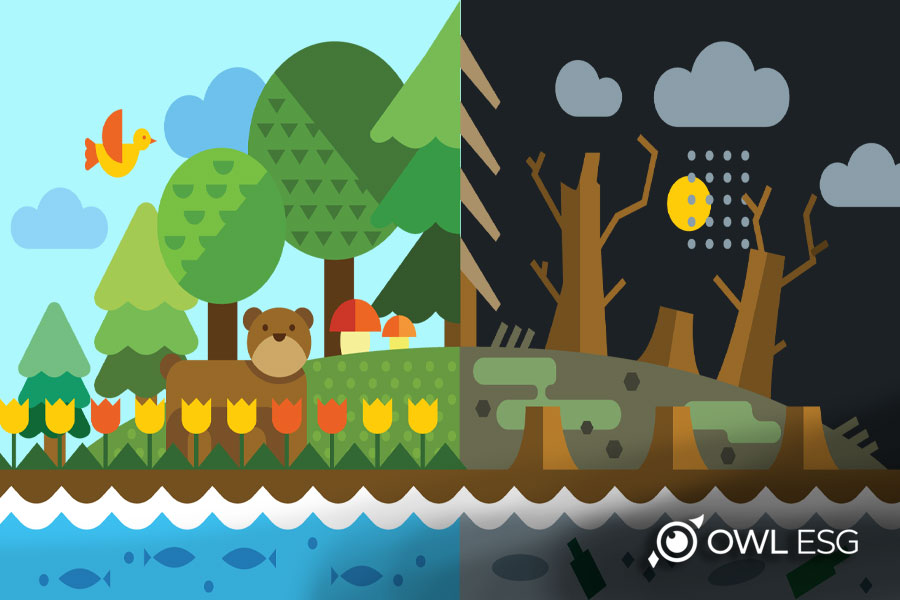A while ago we wrote about the importance of biodiversity, noting that over half of the world’s GDP is highly or moderately dependent on nature. Recent data show that the operations of 85 percent of the 1,200 largest companies in North America, Europe, Asia, Australia, and Latin America depend significantly on nature.
For those who think that preserving biodiversity—which is declining at an alarming rate —is about protecting obscure species that “no one cares about,” this is a reminder that it is essential to many value-creating economic activities. And before we move on from the notion that it’s no big deal if obscure species go extinct, remember that destroying any species upsets the balance of nature that preserves species that everyone cares about, such as plants and animals we humans use as food, medicines, and other products that are part of everyday life.
Let’s assume we agree that biodiversity is important. We also know the earth is undergoing an unprecedented mass extinction event due to climate change and other human activities. But in practical terms, what should businesses do to support biodiversity?
The underlying causes of biodiversity loss
Every species on earth adapts to nature, using what nature provides in balance with the needs of other species that are a part of that balance – except one. Only human beings alter natural habitats to suit our needs, wreaking havoc on ecosystems and destroying biodiversity in the process. Biodiversity loss is primarily attributable to land use changes, pollution, and climate change, all caused by humans. All three reflect a rather cavalier attitude toward exhausting the earth’s natural capital and cause self-inflicted wounds. They are also interrelated.
According to the London School of Economics, 75 percent of ice-free land and 63 percent of oceans have been transformed by humans in some way. Clearing land for agriculture or industrial use kills the flora and fauna that were there before the land was appropriated. It also eliminates the carbon-absorbing ability of whatever grew there (think of trees and other plants as natural, large-scale direct-air carbon capture machines). We are fast approaching the point at which large sections of the Amazon rainforest (the “Earth’s lungs”) will turn into dry savannahs, causing a staggering loss of biodiversity while decimating the rainforest’s CO2-absorbing ability.
To make matters worse, the agricultural activities and industrial processes that use the cleared land generate new carbon emissions and pollutants. Pollutants such as sulfur can raise the acidity of lakes and streams, damage trees, and change the pH of the soil. Too much nitrogen in the air leads to eutrophication in lakes and rivers, a process by which nitrogen and other nutrients overload aquatic ecosystems, causing algae blooms that deprive animals and plants of oxygen. This creates “dead zones” and reduces food sources that we humans care about.
So, damaging natural habitats harms biodiversity, increases pollution, threatens food sources and accelerates climate change, with real-world, economic consequences. If we are going to turn this ship around, we (collectively – governments, businesses, and consumers) have to focus on reducing habitat destruction by getting smarter about land use, reducing pollution, and fighting climate change.
Will more talk lead to more action?
More people are talking about biodiversity – and that’s a good thing. Greenbiz points out that companies in just about every industry (primarily but not exclusively in Europe) have nature-related management roles. For example, H&M has a Head of Climate and Nature, McDonald’s has a Sustainability Director for Nature and Climate, Axa Group (the insurance firm) has a Head of Climate and Biodiversity, Procter & Gamble has a Senior Director, Nature and Biodiversity, and chemical company Henkel has a Global Sustainability Manager for Nature and Biodiversity.
Why this growing interest in biodiversity in major corporations? Is this something shareholders should care about?Emphatically, yes. As with just about everything in the environmental, social, and governance (ESG) space, protecting biodiversity is about reducing risk and identifying new business opportunities. There is a growing recognition that preserving biodiversity and helping nature to regenerate (two sides of the same coin—preserving biodiversity helps ecosystems to regenerate, and ecosystems that regenerate preserve biodiversity) makes economic sense.
Using resources unsustainably means raw materials (including plants used in textiles, building materials, and food) become more scarce and therefore more costly. That drives up prices, which pushes customers to cut back or look for cheaper alternatives (see Econ 101–Elasticity of Demand), which slows economic growth, hurting employment, and so on.
In other words, supporting biodiversity is not just virtue-signaling. While financial impacts are hardly the only reason to protect natural resources, applying that perspective gives biodiversity a more prominent seat at the table. In its 2022 Global Risks Report, the World Economic Forum ranked biodiversity and nature loss as a top three business risk.
No time to waste

Exploiting resources in pursuit of profits now reduces or destroys the availability of those resources later, which reduces a company’s ability to make stuff to generate profits in the future. And we’re not talking about the far-off future; this is about the fairly near term.
The Forbes Business Council argues that the business case for protecting biodiversity is as important as reducing carbon emissions because “degrading ecosystems could trigger a downward spiral of US$2.7 trillion in global Gross Domestic Product by 2030.” The bold emphasis is ours—the year 2030 will be here in the blink of an eye.
Investors are starting to recognize biodiversity risk in risk assessments. A recent Moody’s report states there is $1.9 trillion in rated debt across nine sectors that have “high” or “very high” exposures to natural capital risks, and 24 more industries have a combined $9.6 trillion in rated debt. The Taskforce on Nature-related Financial Disclosures is “creating an integrated framework that builds on existing standards, metrics and data” for companies and financial institutions. Catherine Howarth, CEO at responsible-investment group ShareAction, told the Financial Times that biodiversity is “the fastest-developing ESG theme in global capital markets.”
Greenbiz quotes the VP for Climate Action at Salesforce, Tim Christophersen, who says “the biggest impact on climate change for humanity will come from unraveling and collapsing ecosystems” which, as he notes, gets into ecosystem collapse, food security, energy security, and water security issues. This is why many are now recognizing that biodiversity is as important to address as the climate crisis. And, as we noted above, the two are related—protecting biodiversity helps to fight climate change, and vice versa. The opposite is also true: destroying biodiversity makes climate change worse, and vice versa.
If you’re going to manage something, you have to measure it
Aside from talking about why biodiversity matters, what can companies actually do to make a difference? It’s not all that complicated – in fact, a saying that dates to the 1700s (perhaps earlier) summarizes things nicely: waste not, want not. Stop wasting resources. Don’t use what cannot be replenished. Be more efficient with the resources we have. But it’s not enough for companies to say “we prioritize biodiversity” – we need reporting mandates and metrics.
The Science-Based Targets Network published a five-step process for setting, implementing, and tracking progress toward targets aimed at protecting and restoring nature across freshwater, land, biodiversity, ocean, and climate. But what metrics can we use? What disclosures should companies make so that investors can track progress in this arena? There is a concept of being “nature-positive” – similar to “net zero” but for nature.
That might sound promising, but just as the net zero concept has given rise to the use of carbon offsets with dubious validity (to put it mildly), becoming “nature-positive” by paying someone else not to do something sounds less than ideal. We call for something more direct, such as reporting some type of land-use intensity measure, along with the intensity with which raw materials and packaging are used to generate revenues, and companies’ efforts to cut back and participate full-on in the circular economy.Companies and investors need to understand that nature and biodiversity loss is an existential threat to many sectors of the economy and to society as a whole. And when people protest that it isn’t possible to stop converting land and using natural resources, reply with “we can do better than what we’re doing now, and some progress is much better than the status quo.”
Contact us to find out what OWL offers in this critical area of sustainability.




